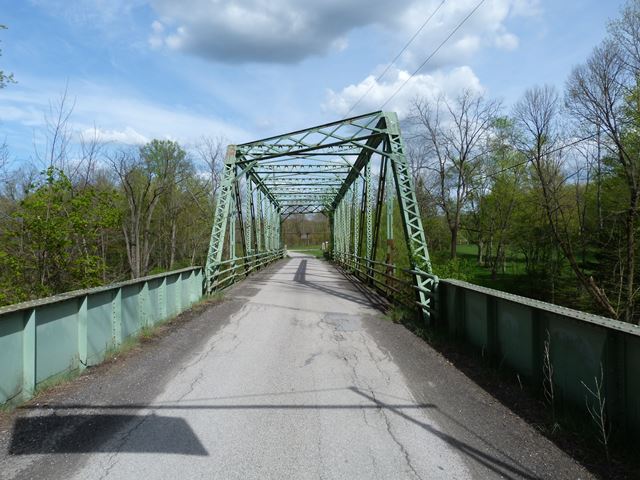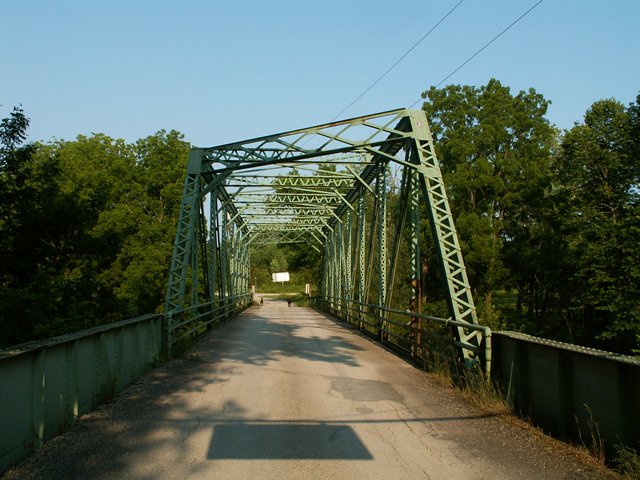We Recommend:
Bach Steel - Experts at historic truss bridge restoration.
BridgeHunter.com Phase 1 is released to the public! - Visit Now
Callender Road Bridge

Primary Photographer(s): Nathan Holth
Bridge Documented: June 30, 2006 and May 6, 2013
Rural: Ashtabula County, Ohio: United States
Metal 8 Panel Rivet-Connected Pratt Through Truss, Fixed and Approach Spans: Metal Through Girder, Fixed
1913 By Builder/Contractor: Massillon Bridge Company of Massillon, Ohio
Not Available or Not Applicable
130.0 Feet (39.6 Meters)
253.0 Feet (77.1 Meters)
16 Feet (4.88 Meters)
1 Main Span(s) and 2 Approach Span(s)
432954

View Information About HSR Ratings
Bridge Documentation
This bridge no longer exists!
View Archived National Bridge Inventory Report - Has Additional Details and Evaluation
This bridge was demolished and replaced in Fall 2013!
This beautiful bridge is a unique structure that features through plate girder approaches with a through truss main span, a very unusual combination of visually contrasted bridge types. At the same time, this span arrangement is aesthetically pleasing, with the smaller low-profile approach spans leading up to the large main span. The bridge is an example of two individually well-known structural types combined into a single structure. In addition, the main truss span is highly unusual. Although the connections are riveted, this is still a lightweight style truss bridge, using member sizes similar to those seen on pin connected structures. The bridge is also skewed, quite noticeably, which makes a bridge of this age noteworthy and uncommon. The truss span on the Callender Road bridge is similar to the truss span on the Harpersfield Bridge. Note the portal bracing design and the unusual feature of v-lacing on both the top and bottom sides of the top chord/end post. The span on Harpersfield was attributed to the Riverside Bridge Company, but it was also built in 1913, the same year as the Callender Road Bridge, in response to a flood that damaged these bridges. However, the Massillon Bridge Company was who reportedly built the Callender Road Bridge. The similarities between the bridges could indicate the county had some input on the design of the bridges despite having different builders construct them. If so, this would represent the trend that was occurring at this time to have the highway agency direct bridge companies to build bridges to the agency's design, not the company's own design. All of these significant traits of the Callender Road Bridge should have been more than enough reason to preserve the bridge instead of demolishing it. Also, the fact that this bridge is on the Grand River, a river designated a "Wild and Scenic River" by the state should be further reason to preserve the bridge. However in the past officially designating rivers as scenic doesn't do anything for a historic bridge, and can even help condemn them, despite the fact that the bridges are an attribute for the river and heritage preservation is one of the stated goals of a Wild and Scenic River designation. See the Shanley Road Bridge for details of where a scenic river designation aided in demolition. If anyone wonders why HistoricBridges.org purposely excludes covered bridges from the website, look at this bridge and look at Ashtabula County as a whole. The county has preserved every single wooden covered bridge they have. Yet, only a few of their historic metal truss bridges have been preserved. Others like this one are being demolished! Metal truss bridges are no less deserving of attention than covered bridges. This bias toward covered bridges and against all other forms of historic bridge is a nationwide problem. There was absolutely no reason to demolish this bridge. It could have and should have been preserved just like the covered bridges.
Information and Findings From Ohio's Historic Bridge InventorySetting/Context The bridge carries a 2 lane road over a stream in a sparsely developed, rural setting. Physical Description The 4-span, 253'-long bridge consists of a 130'-long rivet-connected Pratt thru truss main span, two flanking 56'-long thru girder spans, and one 27'-long steel stringer span. The truss span is skewed. It is traditionally composed of built-up members and gusset plates at the panel points. The end posts are lightly composed of channels with lacing. The lower chords are back-to-back angles with battens. The bridge has a concrete deck supported on rolled stringers framed into the rolled floorbeams. The bridge is supported on concrete abutments and piers. Plumber pipe railings are set to the roadway faces of the truss lines. Integrity The bridge has the aspects of integrity. There is some loss of original fabric from deterioration of the steel, especially in stiffeners and web of thru girder spans at the roadway level. Summary of Significance The 1913 rivet-connected Pratt thru truss bridge is one of four extant examples of the design in the county that were placed to replace ones lost in a flood. All were placed in 1913, which makes them among the
earliest in the state. Why there are so few riveted through truss bridges in Ohio, when the technology to do field riveting was common by 1900, is not known. The four in the county are determined to be technologically significant
because they are early examples within the Ohio context. It is representative of the standard, riveted, Pratt thru-truss type/design that was popular on Ohio's roads from about 1900 to 1940. The truss superstructure is complete with
the exception of some loss of fabric from corrosion. The Massillon Bridge & Structural Iron Company of Massillon, Ohio, was one of the many Ohio bridge-fabricating companies that served the regional market in steel highway bridges
during the early 20th century. Its designs of this period are not distinctive in and of themselves but reflect the increasing standardization of detail that was the hallmark of rivet-connected highway truss type/design. Justification The bridge is one of over 40 extant riveted thru truss bridges of all designs built between 1904 and 1959. This example is representative of the population and has moderate significance. There are also many riveted thru truss bridges servicing the many rail lines in the state. Bridge Considered Historic By Survey: Yes |
![]()
Photo Galleries and Videos: Callender Road Bridge
2006 Bridge Photo-Documentation
Original / Full Size PhotosA collection of overview and detail photos. This gallery offers photos in the highest available resolution and file size in a touch-friendly popup viewer.
Alternatively, Browse Without Using Viewer
![]()
2006 Bridge Photo-Documentation
Mobile Optimized PhotosA collection of overview and detail photos. This gallery features data-friendly, fast-loading photos in a touch-friendly popup viewer.
Alternatively, Browse Without Using Viewer
![]()
2013 Bridge Photo-Documentation
Original / Full Size PhotosA collection of overview and detail photos. This gallery offers photos in the highest available resolution and file size in a touch-friendly popup viewer.
Alternatively, Browse Without Using Viewer
![]()
2013 Bridge Photo-Documentation
Mobile Optimized PhotosA collection of overview and detail photos. This gallery features data-friendly, fast-loading photos in a touch-friendly popup viewer.
Alternatively, Browse Without Using Viewer
![]()
CarCam: Eastbound Crossing
Full Motion VideoNote: The downloadable high quality version of this video (available on the video page) is well worth the download since it offers excellent 1080 HD detail and is vastly more impressive than the compressed streaming video. Streaming video of the bridge. Also includes a higher quality downloadable video for greater clarity or offline viewing.
![]()
Maps and Links: Callender Road Bridge
This historic bridge has been demolished. This map is shown for reference purposes only.
Coordinates (Latitude, Longitude):
Search For Additional Bridge Listings:
Bridgehunter.com: View listed bridges within 0.5 miles (0.8 kilometers) of this bridge.
Bridgehunter.com: View listed bridges within 10 miles (16 kilometers) of this bridge.
Additional Maps:
Google Streetview (If Available)
GeoHack (Additional Links and Coordinates)
Apple Maps (Via DuckDuckGo Search)
Apple Maps (Apple devices only)
Android: Open Location In Your Map or GPS App
Flickr Gallery (Find Nearby Photos)
Wikimedia Commons (Find Nearby Photos)
Directions Via Sygic For Android
Directions Via Sygic For iOS and Android Dolphin Browser
USGS National Map (United States Only)
Historical USGS Topo Maps (United States Only)
Historic Aerials (United States Only)
CalTopo Maps (United States Only)




